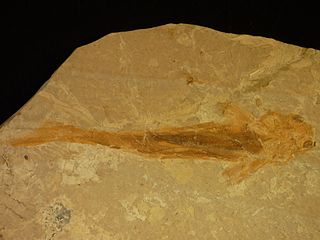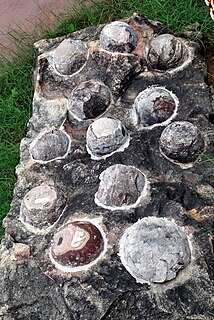
Eobaataridae is a family of fossil mammals within the order Multituberculata. Remains are known from the Lower Cretaceous of Europe and Asia. They are among the most derived representatives of the informal suborder "Plagiaulacida", and closely related to Cimolodonta. Most eobaatarids are only known from isolated teeth, though several reasonably complete members are known, including Sinobaatar and Jeholbaatar. The body of Sinobaatar is generalised, while Jeholbaatar displays clear adaptations for scansoriality (climbing) due to its elongated digits. Due to the morphology of the cheek teeth, Eobaatar and Jeholbaatar are inferred to be omnivorous, likely feeding on plants and invertebrates.

Changchunsaurus is an extinct genus of small herbivorous dinosaur from Early Cretaceous deposits of Gongzhuling, Jilin, China. It is the first named dinosaur genus from Jilin.

Jiangshanosaurus is a genus of herbivorous titanosauriform sauropod dinosaur that lived in China approximately 92-88 million years ago, during the Turonian-Coniacian stage of the Late Cretaceous.

Dongyangosaurus is a genus of titanosaurian sauropod dinosaur from the Late Cretaceous. The only species is Dongyangosaurus sinensis, from which only a single fragmentary skeleton is known, coming from the Zhejiang province of eastern China. It was described and named by Lü Junchang and colleagues. Like other sauropods, Dongyangosaurus would have been a large quadrupedal herbivore.

Gobiconodon is an extinct genus of carnivorous mammal from the Middle Jurassic to Early Cretaceous. It weighed 10–12 pounds (4.5–5.4 kg) and measured 18–20 inches (460–510 mm). It was one of the largest mammals known from the Mesozoic. Like other gobiconodontids, it possesses several speciations towards carnivory, such as shearing molar teeth, large canine-like incisors and powerful jaw and forelimb musculature, indicating that it probably fed on vertebrate prey; rather uniquely among predatory mammals and other eutriconodonts, the lower canines were vestigial, with the first lower incisor pair having become massive and canine-like. Like the larger Repenomamus there might be some evidence of scavenging.

Kansajsuchus is an extinct genus of paralligatorid mesoeucrocodylian. It is based on PIN 2399/301, a right premaxilla, one of the bones of the tip of the snout. This specimen was found in rocks of the lower Santonian-age Upper Cretaceous Yalovach Svita of Kansai, in the Fergana Basin of Tajikistan. Additional fossils including vertebrae and bony armor have been assigned to this genus. It would have been a large animal, estimated at up to 8 metres (26 ft) long. Kansajsuchus was described in 1975 by Mikhail Efimov. The type species is Kansajsuchus extensus.

Turanosuchus is an extinct genus of paralligatorid crocodyliform. It is based on PIN 2229/507, a partial lower jaw consisting of the area where the two halves of the lower jaw meet. This specimen was found in rocks of the lower Santonian-age Upper Cretaceous Bostobe Svita of Shakh-Shakh, southern Kazakhstan. Turanosuchus was described in 1988 by Mikhail Efimov. The type species is T. aralensis. Halliday et al. (2015) revised the material attributed to T. aralensis and concluded that it represents non-diagnostic neosuchian material, and as such the genus was considered to be a nomen dubium.

Peipiaosteus is an extinct genus of prehistoric chondrostean ray-finned fish. Its fossils are found in the Early Cretaceous Jiufotang Formation, Pani Lake, Liaoning Province, China.

Paralligator is an extinct genus of neosuchian crocodylomorph that lived during the Late Cretaceous (Cenomanian-Maastrichtian) period in what is now the Bayan Shireh and Nemegt formations of Mongolia, approximately 96 million to 70 million years ago.

Paralligatoridae is an extinct family of neosuchian crocodyliforms that existed during the Jurassic and Cretaceous periods. It includes the genera Paralligator, Brillanceausuchus, Kansajsuchus, Shamosuchus, Scolomastax, Sabresuchus, Rugosuchus, Batrachomimus and Wannchampsus, as well as the yet-unnamed "Glen Rose form".
Acristatherium yanensis is an extinct basal eutherian from the Early Cretaceous Lujiatun Bed of the Yixian Formation. It was described on the basis of a single specimen (holotype) from Beipiao, Liaoning, China, by Yaoming Hu, Jin Meng, Chuankui Li, and Yuanqing Wang in 2010. The specimen comprises a partial skull, 25 mm (0.98 in) long. It appears to possess a vestige of a septomaxilla, a feature only otherwise seen in nonmammalian therapsids.

Liaoconodon is an extinct genus of early mammal from the early Cretaceous. It is a eutriconodont which lived in what is now the Jianchang of Liaoning Province, eastern China. It is known from the holotype IVPP V 16051, which consists of nearly complete skeleton and skull. It was found in the Jiufotang Formation near Xiaotaizi, Lamadong. It was first named by Jin Meng, Yuanqing Wang and Chuankui Li in 2011 and the type species is Liaoconodon hui.
Yueosaurus is an extinct genus of basal ornithopod dinosaur known from Zhejiang Province, China.

Egg fossils are the fossilized remains of eggs laid by ancient animals. As evidence of the physiological processes of an animal, egg fossils are considered a type of trace fossil. Under rare circumstances a fossil egg may preserve the remains of the once-developing embryo inside, in which case it also contains body fossils. A wide variety of different animal groups laid eggs that are now preserved in the fossil record beginning in the Paleozoic. Examples include invertebrates like ammonoids as well as vertebrates like fishes, possible amphibians, and reptiles. The latter group includes the many dinosaur eggs that have been recovered from Mesozoic strata. Since the organism responsible for laying any given egg fossil is frequently unknown, scientists classify eggs using a parallel system of taxonomy separate from but modeled after the Linnaean system. This "parataxonomy" is called veterovata.
Aprosuchus is a genus of small-bodied Maastrichtian atoposaurid Eusuchian from the Hateg Basin, Romania.
Scolomastax is an extinct genus of paralligatorid neosuchian known from the Late Cretaceous Woodbine Formation in Texas. It contains a single species, S. sahlsteini.
Tarsomordeo is an extinct genus of paralligatorid neosuchian known from the Early Cretaceous Twin Mountains Formation in Texas. It contains a single species, T. winkleri.

Peipiaosteidae is an extinct family of fish, known from the Late Jurassic and Early Cretaceous of Asia. It is considered to be a member of Acipenseriformes, related to sturgeons (Acipenseridae) and paddlefish (Polyodontidae). Fossils have been found in freshwater deposits in China, Russia, Kazakhstan, and Mongolia. They are generally considered either the earliest diverging group of Acipenseriformes, or the sister group to the clade containing Acipenseridae and Polyodontidae.
Brevirostruavis is a genus of Early Cretaceous enenatiornithine bird from the Early Cretaceous Jiufotang Formation of Liaoning, China. The type and only species is Brevirostruavis macrohyoideus.
This article records new taxa of fossil archosaurs of every kind that are scheduled described during the year 2022, as well as other significant discoveries and events related to paleontology of archosaurs that are scheduled to occur in the year 2022.














